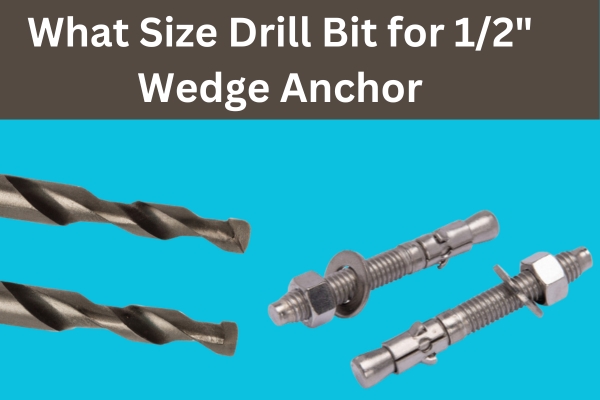Embarking on a construction or DIY project demands precision, especially when securing structures in concrete. Wedge anchors offer robust support, but the drill bit size needs to be noticed, risking project integrity.
The 1/2-inch wedge anchor is prized for its strength, yet drilling precision remains key. Discovering the correct drill bit size is pivotal for success.
Our guide navigates this essential aspect, revealing the intricacies of choosing the precise drill bit for a 1/2-inch wedge anchor. Uncover key factors influencing the selection and gain practical tips for concrete drilling. Let’s demystify this critical detail, empowering you to execute projects with confidence and accuracy.
What Size Drill Bit for 1/2″ Wedge Anchor – Step-by-Step Guide

Step-1. Introduction to Wedge Anchors
When it comes to securing heavy loads or fixtures into concrete, wedge anchors serve as reliable fasteners. Understanding the correct drill bit size for 1/2″ wedge anchors is crucial for ensuring their proper installation and effectiveness.
Step-2. Understanding about Drill Bit Sizes
Drill bits come in various sizes, each suited for specific applications. The size of a drill bit is determined by its diameter, measured in inches or millimeters. Different anchor sizes require corresponding drill bit sizes for optimal installation.
Step-3. Importance of Correct Drill Bit Size for 1/2″ Wedge Anchors
Using the right size drill bit is essential for achieving a snug fit and maximum holding capacity. Incorrect sizing can lead to loose anchoring, compromising the stability and safety of the fixture.
Step-4. Determining the Right Size Drill Bit
Measuring Anchor Diameter
Before drilling, accurately measure the diameter of the 1/2″ wedge anchor. This measurement will guide the selection of the appropriate drill bit size.
Referencing Manufacturer Guidelines
Manufacturers often provide guidelines specifying the recommended drill bit size for their wedge anchors. For optimal performance, you must adhere to these specifications.
Step-5. Common Mistakes and Their Impacts
An incorrect drill bit size can result in issues such as loose anchors, reduced load-bearing capacity, and compromised structural integrity. Understanding these mistakes helps in avoiding them during installation.
Step-6. Steps to Drill Holes for 1/2″ Wedge Anchors
Preparing the Surface
Ensure the concrete surface is clean and free from debris before drilling. This ensures a smooth and precise drilling process.
Choosing the Right Drill
Select a high-quality drill suitable for drilling into concrete. Use a hammer drill for efficient and accurate hole creation.
Drilling Process
Drill the holes to the recommended depth using the correctly sized bit. Maintain a steady hand and consistent pressure while drilling.
Step-7. Ensuring Proper Installation
The 1/2″ wedge anchor should be inserted into the hole and tightened securely. Verify that the anchor is flush with the surface and not overtightened.
Step-8. Advantages of Using Correct Drill Bit Sizes
Using the right drill bit size ensures a tight and secure fit for the anchor, maximizing its load-bearing capacity and providing overall structural stability.
When the correct drill bit size is employed, the wedge anchor’s effectiveness is enhanced, preventing potential issues like loosening over time due to improper fitting.
Step-9. Factors Affecting Anchor Installation
Several factors beyond drill bit size influence the successful installation of 1/2″ wedge anchors. Factors such as the quality of the concrete, environmental conditions, and proper torque during installation play pivotal roles in ensuring the anchor’s longevity and effectiveness.
Quality of Concrete
The quality of the concrete significantly impacts the anchor’s performance. Cracks, weak spots, or inconsistencies in the concrete can affect how well the anchor holds.
Environmental Conditions
Environmental factors like temperature and humidity can affect the curing time of the concrete. Extreme conditions may influence the anchor’s stability, emphasizing the need for proper installation techniques.
Torque During Installation
Applying the correct torque while tightening the wedge anchor is crucial. Over-tightening can damage the anchor or the surface, while insufficient torque may result in a loose fit.
Step-10. Maintenance and Inspection
Regular maintenance and inspection of installed wedge anchors are essential to ensure ongoing safety and reliability. Periodic checks for any signs of corrosion, loosening, or structural changes help prevent potential hazards.
Corrosion Prevention
Protecting wedge anchors from corrosion, especially in outdoor or high-moisture environments, is vital. Coatings or treatments can be applied to increase the anchor’s longevity.
Inspection Frequency
Regular inspections, preferably scheduled annually or biannually, can help identify any degradation or issues early, preventing accidents or structural failures.
Conclusion:
I hope, In this article, you have got info about what size drill bit for 1/2″ wedge anchor. Choosing the correct drill bit size for 1/2″ wedge anchors is fundamental in achieving a secure and reliable installation. Adhering to manufacturer guidelines and accurate measurement are key steps in ensuring optimal performance and safety.
Thank you for the reading!
FAQs:
Can I use a larger drill bit for a 1/2″ wedge anchor?
A larger drill bit may compromise the anchor’s stability, leading to a loose fit and reduced load-bearing capacity. It’s essential to use the recommended drill bit size for optimal performance.
What happens if I use a smaller drill bit for a 1/2″ wedge anchor?
Using a smaller drill bit can result in a tight fit or difficulty in inserting the anchor properly. It might also weaken the concrete, affecting the anchor’s holding capacity.
How deep should I drill for a 1/2″ wedge anchor?
Refer to the manufacturer’s guidelines for the recommended depth. Typically, the hole depth should accommodate the anchor length and allow space for debris clearance.
Can I reuse a wedge anchor after removal?
Wedge anchors are generally not reusable after removal. Once removed, they may lose their effectiveness and structural integrity.
Is it necessary to use a hammer drill for drilling into concrete?
Using a hammer drill is recommended for drilling into concrete as it provides the necessary impact force to penetrate the surface effectively.
